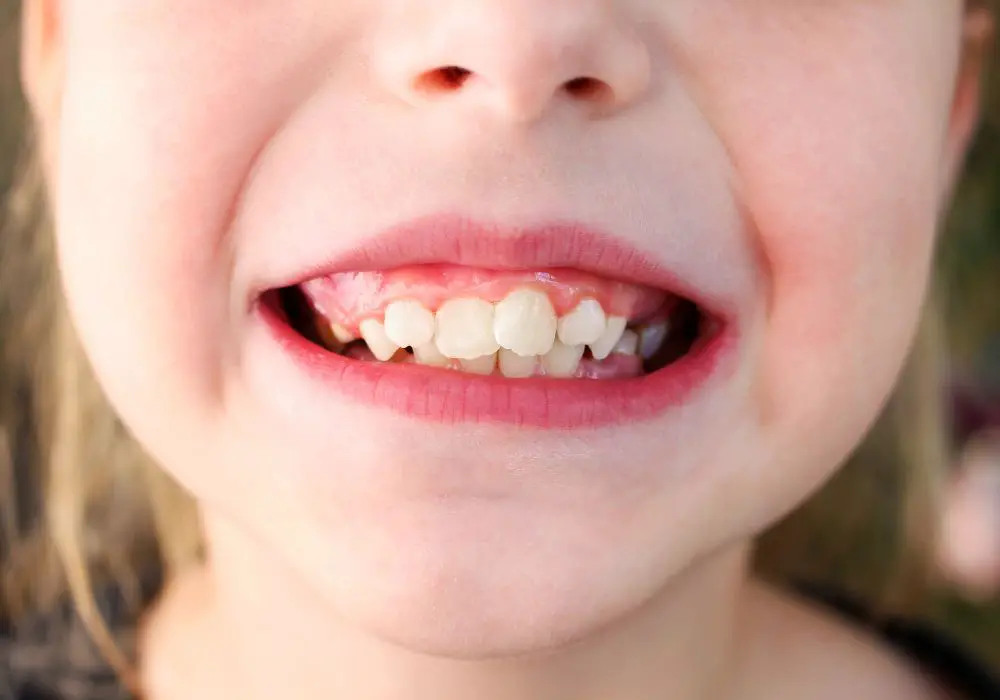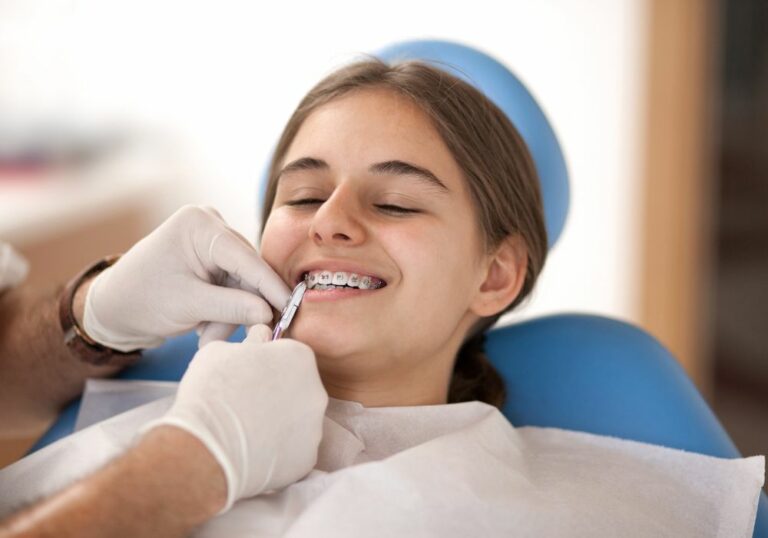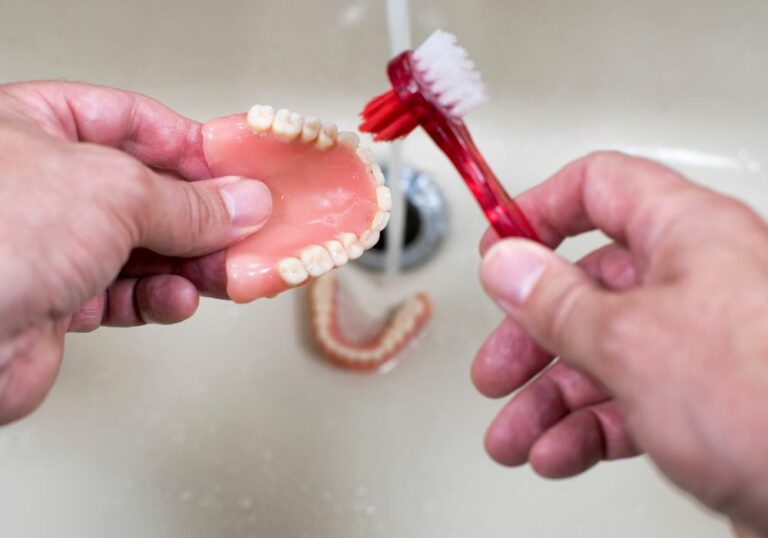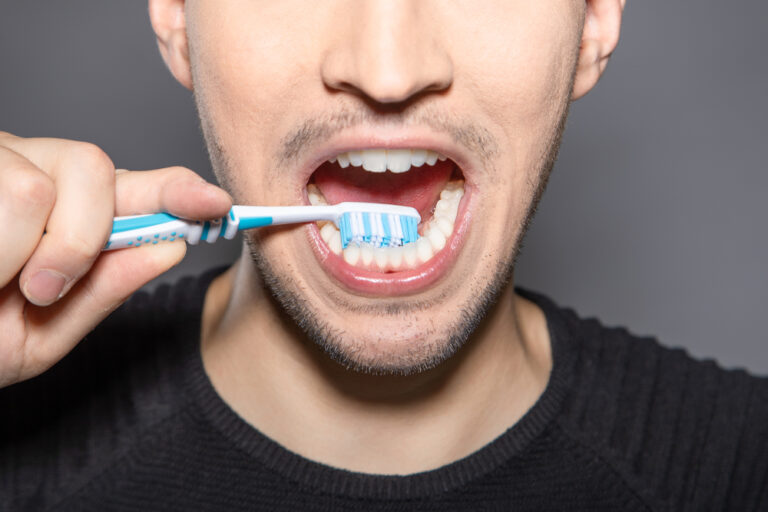What Causes Teeth to Become Unusually Sharp?
There are a number of potential causes for a tooth developing a sharp, painful edge. Determining the origin of the problem is an important first step toward finding the right treatment approach.
Chipped or Broken Teeth

Teeth may chip or crack from trauma such as sports injuries, falls, accidents, or getting hit in the mouth. The impact can shear off enamel, exposing rough, sensitive dentin underneath. In some cases, a piece of the tooth breaks off entirely, leaving a jagged, uneven edge.
Symptoms
- Sharp, cutting sensation when tongue touches the tooth
- Sensitivity to hot and cold
- Difficulty chewing without pain
- Visible chip, crack, or missing chunk of tooth
Treatments
- Bonding – applying composite resin to fill the gap
- Veneers or crowns – covering the entire tooth with porcelain or ceramic
- Root canal – if the pulp is damaged from a deep crack
- Extraction – removing the tooth if severely damaged
Worn Tooth Enamel
As we age, the enamel naturally wears down from a lifetime of chewing, grinding, and consuming acidic foods and drinks. This exposes the softer dentin interior, which may feel sharp or abrasive to the tongue. The thinner enamel is also more susceptible to chipping and erosion.
Symptoms
- Translucent or discolored areas indicate thinning enamel
- Yellowish dentin showing through the enamel
- Teeth feeling rough, ragged, or sharp
- Height reduction from gradual enamel loss over time
Treatments
- Enamel shaping to smooth rough spots
- Tooth-colored fillings to build up worn areas
- Porcelain veneers or crowns to cover worn teeth
- Prescription toothpaste for added enamel protection
Bruxism (Teeth Grinding or Clenching)
People who grind or clench their teeth, often during sleep, can crack, fracture, and wear down the enamel. This damage leads to sharp, uneven biting surfaces and hypersensitivity. Grinding and clenching puts extreme pressure on the teeth.
Symptoms
- Broken, fractured, or chipped teeth
- Flattened or short teeth from attrition
- Jaw and facial muscle soreness
- Headaches or ear pain upon waking
Treatments
- Occlusal nightguard to protect the teeth from grinding
- Botox injections to relax grinding muscles
- Stress reduction techniques to prevent clenching
- Tooth repair procedures like veneers, crowns, or fillings
- Orthodontics to correct bite issues contributing to the problem
Crooked, Crowded, or Misaligned Teeth
When teeth overlap each other or are severely crooked, the contacting edges can become worn and sharp. Normal chewing grinds them against each other. Orthodontic braces are often needed at a young age to prevent malocclusion.
Symptoms
- Jagged, rough tooth surfaces
- Pain or discomfort from rubbing
- Difficulty cleaning between crowded teeth
- Poor bite function
Treatments
- Orthodontic treatment such as braces or Invisalign
- Selective enamel shaping to smooth edges
- Extraction of problematic teeth to relieve crowding
- Restorations like veneers to protect worn areas
Risks and Dangers of Using Sandpaper on Teeth

In an attempt to smooth or dull a sharp tooth edge, some people are tempted to use sandpaper. However, this is an unsafe, damaging approach that should always be avoided. Here are the main risks involved:
Permanent Enamel Loss
The enamel is the ultra-hard, protective outer shell of the tooth. Sandpaper is highly abrasive and will permanently strip and scrape away enamel. This causes irreversible damage and exposes the sensitive, decay-prone layer underneath. Once enamel is worn down or thinned, it cannot be replaced or regrown.
Increased Tooth Sensitivity
Losing surface enamel exposes the softer dentin, which contains microscopic tubules leading to the inner tooth nerves. Air, cold, heat, sweet foods, and touch stimuli can then easily trigger pain signals. This tooth sensitivity may be permanent after excessive abrasion.
Accelerated Tooth Decay
Sanding leaves microscopic grooves, pores, and openings which allow bacteria to infiltrate deeper into the tooth structure. Bacteria then multiply and produce acids that breakdown the enamel further. More decay and erosion inevitably follows.
Destruction of Tooth Anatomy
The natural shape, contours, ridges, and anatomy of the tooth are important to its function. Filing or sanding can obliterate these features, negatively impacting chewing ability and occlusion with other teeth. It also ruins the aesthetic appearance.
Potential Nerve Exposure
Aggressive sanding could expose the pulp chamber and innervated tissues. This causes severe, shooting nerve pain and usually requires immediate root canal treatment or extraction altogether. This is a disastrous outcome to be avoided.
Emergency Dental Repairs
After sandpaper use, the tooth becomes so structurally unsound that emergency restorative work is needed to try to salvage it. This may involve extensive procedures like root canals, gum surgery, crowns, or bridgework.
Eventual Tooth Loss
With so much irreversible destruction caused, the tooth often cannot be saved long-term. Once decay sets in below the damaged enamel layer, extraction becomes inevitable. This is a much worse outcome than simply leaving the original sharp edge alone.
Safe, Effective Ways to Smooth Sharp Teeth
While sandpaper should never be used, there are several safe professional methods to reshape and smooth down sharp teeth:
Dental Handpiece Filing
- Uses a smooth, fine diamond bur controlled by the dentist’s handpiece.
- Safely and precisely targets small areas.
- Removes just minute amounts of enamel.
- Leaves a natural, smooth finish.
Air Abrasion
- Blasts away tiny enamel particles using a focused jet of air and water or abrasive powder.
- Less heat and vibration than conventional drilling.
- Provides excellent control for detailed reshaping.
Enamelplasty
- Selectively contours and reshapes the biting and chewing surfaces of teeth only.
- Restores proper function and relief without aesthetic changes.
- Creates a more ideal occlusion.
Dental Bonding
- An adhesive resin material is applied to worn, uneven teeth.
- Shaped and hardened with a curing light to smooth rough spots.
- Matches the natural tooth shade for seamless appearance.
Veneers and Crowns
- Thin shells of dental ceramic or porcelain covers the front and top of teeth.
- Improves aesthetics and provides even chewing surfaces.
- Protects worn or damaged enamel.
Orthodontic Correction
- Braces, wires, and other appliances can align crooked teeth.
- Eliminates uneven biting surfaces caused by malocclusion.
- Restores proper function and a balanced bite.
With professional guidance, even severely sharp, malformed, or damaged teeth can be safely smoothed and restored to full function and aesthetics. Avoid any temptation to use sandpaper or other abrasives at home.
Temporary Methods to Reduce Sharp Tooth Discomfort at Home

While waiting to see a dentist, you can temporarily dull the sensation of a sharp tooth using the following methods:
Soft Emery Boards
- Look for ultra-fine, soft grit emery boards made for nails. 180 grit is ideal.
- Lightly buff just the raised, pointed tip of the tooth.
- Apply minimal pressure and avoid reducing the overall tooth height.
Sensitive Toothpaste
- Brands like Sensodyne contain compounds to numb nerve responses.
- Helpful if sharp edges are causing temperature sensitivity.
- Apply directly to the tooth and let sit before rinsing.
Wax Cubes or Dental Putty
- Applied to cover and cushion sharp areas.
- Acts as a protective barrier while eating.
- Only very short term use is recommended to avoid bacteria trapping.
Wet Toothbrush with Baking Soda
- Dip a soft brush in water and baking soda.
- Gently use circular motions on the tooth for 30 seconds.
- Rinse thoroughly. Can help remove debris making it feel sharp.
Desensitizing Mouthwash
- Look for brands containing potassium nitrate or stannous fluoride.
- Swish it around the affected tooth for 1 minute before spitting.
- Use twice daily for the numbing effect.
These can provide minor relief but do not solve the underlying problem. See a dentist to have the tooth properly smoothed, restored, or repaired.
When to Seek Emergency Dental Care for a Sharp Tooth
In most cases, a mildly sharp tooth does not constitute a true dental emergency. However, some symptoms do require urgent, same-day treatment:
- Uncontrolled bleeding from the tooth and gum area
- Sudden, severe throbbing pain in the tooth preventing sleep or eating
- Tooth is visibly cracked down into the root or gum line
- Facial swelling around the tooth
- Tooth was knocked out or broken due to trauma
- Fever and feeling unwell along with the tooth pain
- Difficulty breathing or swallowing
These suggest a possible dental abscess, infection, or trauma injuring the tooth’s vital nerves. See an emergency dentist immediately if any of these warning signs are present. Leaving them untreated allows the problem to quickly escalate.
Other reasons to seek emergency dental care for a sharp tooth include:
- Over-the-counter analgesics provide no relief from the tooth pain
- The tooth pain interferes with sleep, eating, and daily life
- The sharp tooth is preventing you from brushing properly
- The discomfort and sensitivity are progressively worsening
The emergency dentist can diagnose the cause, provide stronger prescription pain medication, and start appropriate treatments like antibiotics or temporary fillings until further dental work can be scheduled. They can also smooth the edge for temporary relief.
What to Expect at the First Dental Visit for a Sharp Tooth

During your first non-emergency dental appointment for a sharp tooth edge, the dentist will likely:
- Review your medical and dental history – including any recent injuries, trauma, or teeth grinding habits.
- Examine the tooth visually and manually – feeling for cracks, decay, or damage. They will note size, shape, and alignment.
- Take diagnostic x-rays – to see below the visible enamel and evaluate the roots and bone structures.
- Check for bite imbalances – improper occlusion with other teeth can cause sharp areas.
- Test sensitivity – using temperature stimuli and probing to locate any inner pulp exposures.
- Discuss symptoms thoroughly – learn how long it has been bothering you, pain levels, and impact on eating.
- Explain treatment options – filing, bonding, crowns, etc. along with timeframes and cost estimates.
- Take impressions – if crowns, veneers, dentures, or guards need fabricating. Send models to a dental laboratory.
- Provide temporary relief – light enamel filing or desensitizing to make you more comfortable until further treatment.
- Schedule follow-up visit – for completing the required procedures once models, bites, or lab work are finalized.
Do not use sandpaper or attempt procedures like crown prep on your own. Work with your dentist to ensure proper diagnosis and treatment tailored to your specific tooth issue.
Long-Term Outcomes of Common Sharp Tooth Treatments
If left untreated, sharp tooth edges typically lead to worsening decay and damage over time. Here are the long-term outlooks for common professional treatment options:
| Procedure | Durability | Eventual Outcome |
|---|---|---|
| Enamel shaping and dental filing | 6 months – 2 years | Repeating filing needed as sharpness returns |
| Tooth-colored composite fillings | 5-10 years | Replacement fillings needed as material breaks down |
| Porcelain veneers | 10-20 years | Veneer repair or replacement may be needed |
| Dental crowns | 15-30 years | Replacement crowns likely needed in future |
| Orthodontic alignment | Permanent if retainers worn | Teeth remain properly positioned |
| Tooth extraction | N/A | Space requiring implant or bridge |
With good oral hygiene and avoiding habits like teeth grinding, treatment results can last for many years or even permanently in some cases. Getting optimal longevity requires maintaining the restorations properly and seeing your dentist for routine exams to monitor for any new problems.
Frequently Asked Questions About Sharp Teeth
1. Should I seek emergency care for a mildly sharp tooth causing minor discomfort?
No, emergency dental clinics are for treating severe, sudden pain along with other warning signs like swelling, bleeding, trauma, or difficulty breathing. For mild sharpness, make a regular or prompt dental appointment.
2. Can teeth be sharpened naturally, or do they require a dental procedure?
Teeth generally become sharp due to damage like fractures, chipping, or excessive grinding over time. Seeing a dentist is required for definitive treatment like filing, crowns, orthodontics or sometimes extraction if the tooth cannot be saved.
3. Is a tooth sharpness always symptomatic, or can it develop silently?
It is possible for enamel loss and dentin exposure to progress slowly without any noticeable discomfort at first. But eventually, temperature sensitivity, pain while chewing, and other symptoms are likely. Seeing your dentist at the first suspicion is best.
4. What home remedies can I use for temporary relief before my dental visit?
You can try an emery board, desensitizing toothpaste, wax, baking soda and brushing, or over-the-counter numbing gel. These provide minimal relief but do not address the underlying problem. Use only gentle, non-abrasive methods.
5. If a sharp tooth is not bothering me, do I still need to get it treated?
Yes, having it evaluated and corrected is important to prevent long-term damage. A sharp edge worsens enamel erosion and decay over time. It can lead to pulp infections requiring root canals or extractions later if neglected.







